Duramax Johnson Cutless Bearings / Cutlass Bearings – Complete Guide
Note: If looking to purchase Johnson Cutless Bearings, see here. We carry the complete line. For more information on how Cutless Bearings work, when and how to change your bearing, and more, see below!
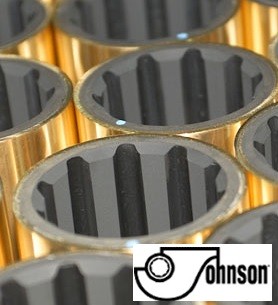 Your propeller shaft will turn thousands of revolutions per minute (RPM) for hundreds and hundreds of hours while under way, with seawater acting as the sole lubricant.
Your propeller shaft will turn thousands of revolutions per minute (RPM) for hundreds and hundreds of hours while under way, with seawater acting as the sole lubricant.
Your Johnson Cutless Bearing (also known as “cutlass” bearing) is a fluted rubber tube that holds your propeller shaft in place, and keeps it spinning smoothly. The inboard end of your propeller shaft is generally supported by the coupling attached to the transmission, and the other end of the shaft is usually held within the cutless bearing in a stern tube mount or strut, some distance from the keel.
Johnson Cutless Bearings by Duramax Marine are made from a hard, rubbery substance called nitrile, and are designed with flutes or valleys that improve the flow of water through the bearing, and that also allow the flushing away of any grit or hard material that may start to wear down your shaft.
The outer shell of Johnson Cutless Bearings either come in naval brass, or in a non-metallic, fiberglass material, appropriate for when aluminum struts or stern tubes can cause corrosion.
What Advantages Do Duramax Johnson Cutless Bearings Have Over Other “Cutlass Bearings”?
While the term “cutless” is more appropriate than “cutlass” (the idea is that the bearings do not cut the shaft, hence the word “cut-less”, a cutlass is better known as a pirate sword), they are both commonly used in this day and age for the same thing = a shaft bearing, also known as a sleeve or stave bearing. However, Duramax Marine, makers of Johnson Cutless Bearings, trademarked the term… so they are the real “cutless” bearings…
I can go on for a while regarding the etymology of the word, but with over 50 years in the bearing business, no other brand of water-lubricated bearing is used in more vessels than a Johnson Cutless Bearing. Even in the harshest of ocean environments, Johnson Cutless Bearings thrive and survive for years, earning the trust and respect of marine professionals and recreational boaters worldwide.
Johnson Cutless Bearings meet United States Military Standards for Class II Full-Molded Type and have full type approval from the American Bureau of Shipping. Bearings must pass a number of stringent performance tests to receive these approvals.
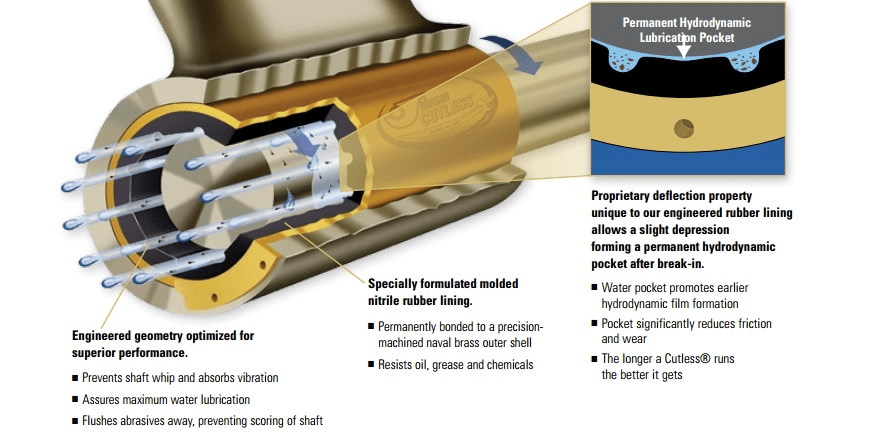
Superior Manufacturing, Equals A Better Bearing
Most other cutlass bearings are manufactured using centerless grinding techniques. While creating a smooth finish, centerless grinding techniques do not take into consideration the inside diameter of the bearing, oftentimes creating a bearing where the centers of the outside and inside diameter may not be the same. When you install a cutlass bearing like this into a housing, the shaft may be off-center in the bearing.
Johnson Cutless Bearings are machined on the inside diameter. Once the inside is bored to the correct dimension, the outside diameter is machined to the correct dimension, resulting in a superior bearing concentricity.
Quality Inspection
Using plug gages for cutlass bearings smaller than 6″, and ID Micrometers for larger sizes, Duramax Marine verifies the accuracy of dimensions for every one of their Johnson bearings that is machined. Bearings are also inspected for blemishes, imperfections, and delamination in both the rubber and outer shells. Bond between rubber and shell is also checked.
- For a complete selection of Duramax Johnson Cutless Bearings for sale, see here…
What Are The Differences Between the Johnson Cutless Naval Brass Sleeve, Non-Metallic Sleeve, and Solid Naval Brass Flanged Bearings?
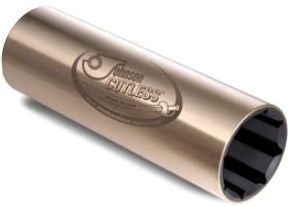
Johnson Cutless Naval Brass Sleeve Bearings adapt equally well to both strut and stern tube mounts, and can be used effectively as rudder-stock and pintle bushings. Cutlass Bearing diameters are precision fitted to the designated shaft size with the correct clearance for efficient water lubrication. The external brass shells are machined and polished to provide easy fitting.
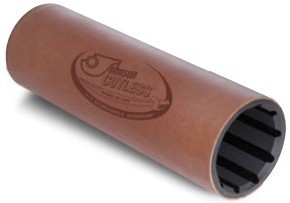
Johnson Cutless Non-Metallic Sleeve Bearings feature a dense structure of engineered reinforced thermoset plastic (almost like a fiberglass), as well as the same Rubber Nitrile on the interior. The material, being non-corrosive and anti-electrolytic, is ideal for installations wherever corrosion or electrolysis is an issue.
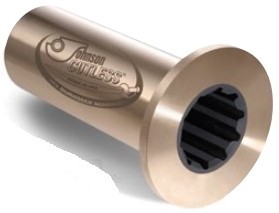
Johnson Cutless Solid Naval Brass Flanged Bearings are centrifugally cast naval brass with an integral flange for bolting to stern tube or strut housing to retain bearing and prevent rotation in housing. Shells are heavy walled, providing structural strength and can be step turned if desired. Flanges are furnished un-drilled unless specified. Drilling instructions come with bearing.
How Do I Know When It’s Time To Change My Cutlass Bearing?
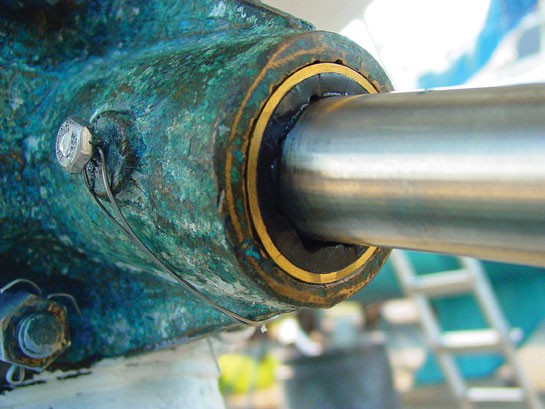 While some may say you should change your cutlass bearing after a set amount of time (say 500 hours of use), this is just not true.
While some may say you should change your cutlass bearing after a set amount of time (say 500 hours of use), this is just not true.
As long as there is no “play”, or lateral movement of the propeller shaft while in the bearing, and your prop shaft is sitting solid / still in the bearing, then your cutlass bearing should still be good. However, if you notice some movement or “wiggle” of the shaft in the bearing (more than 1/16th of an inch), you should strongly consider changing your bearing.
A bad cutlass bearing and loose propeller shaft can lead to problems such as reduced efficiency, or more seriously, with the vibration of the propeller shaft, you can seriously damage your shaft seal, gear box bolts and couplings, engine mounts, and may even lose your entire propeller shaft.
Tip: While the cutless bearing is wet, you may not notice any play in the prop shaft. You should haul the boat, and allow the bearing to dry for a week or more before checking if the bearing needs to be replaced.
Another indicator that it is time to change your cutlass bearing is if you hear a rumbling or vibration that increases over time. The sound of a bad bearing is kind of like a drumming – if you hear this, it is past time to change your bearing.
Instructions for Replacing A Cutlass Bearing

These instructions deal with replacing a cutlass/ cutless bearing in a strut, as opposed to in a shaft log or a keel. For instructions on how to replace a cutlass bearing in a shaft log or keel, see here…
While some cutlass bearing replacement tools are handy, and can allow the removal and installation of a cutless bearing without taking out the propeller shaft (see video below), they can be quite pricey, especially if you are not going to be performing this job on a regular basis. These instructions focus on the removal of a cutless bearing once the prop shaft has been removed.
Step 1) Remove the Set Screws (if your strut has set screws). You may need to clean around the screw, as crud and growth may have built up over time. If your strut has no screws, move on to step 2).
Step 2) Cut into the Bearing. If your strut came with set screws, make a cut into the rubber nitrile material right flush at the same height as the bottom or top of the holes where the set screws go. This will allow the bolts/screws to push at the cut to split it inward. Without set screws, two cuts equally set on opposite sides of the nitrile rubber will work.
Use a hack saw to make the cut, and not a power saw (unless you are very skilled with the power saw). Leave a paper thin amount of the strut on each side – do not cut all the way through, as you may cut the strut (not that serious, but over time, many cuts to the strut is not good).
Step 3) Bend Cutlass Bearing Inward. Use a cold chisel and dead blow hammer to make the first split of the bearing by setting it on the edge and pounding inward. Be careful with the strut when doing this. This will begin the ripping of the thin surface left in cutlass bearing. Once the rip has started, insert some hex bolts into the set screw holes and tighten them evenly and you’ll collapse the cutlass inward.
If your strut doesn’t have set screws, use a maple dowel or piece of thin fiberglass pounded between the strut and the bearing to split it along its entire length. Do not use a screw driver or metallic object, as this can easily damage the inside of the strut. Use an object with a material that is softer in composition than the strut.
Step 4) Twist and Pull the Bearing Out. Once you’ve bent the bearing inward, grip it with a pair of vice grips, and twist it in the direction of the bend while pulling at the same time.
Step 5) Polish / Clean the Inside of the Strut, without sanding, or damaging the inside of the strut, use a wet 320 sand paper to clean the inside. Another option, if you have the tool, is to clean the bearings mating surface with a Dremel with the Magic Wand attachment and an abrasive buff. 30 seconds is all you need.
Step 6) Install the Cutlass Bearing. Installing the bearing requires some threaded rod (use at least 1/2″), four nuts, and some large / thick washers.
The hardest part is getting the bearing started. Care must be taken to get it perfectly straight before beginning to tighten the threaded rod — If it goes in crooked it will bind and you may ruin the bearing.
You should lube the inside of the strut and the outside of the bearing with regular soap in bar foam, such as Ivory. Once the soap gets wet, it will dissipate, but will provide you with a decent lube for now.
Step 7) Finishing Touches. Use a spark plug wrench to slide over the threaded rod and a deep drive socket on the other end. There will be some major force needed to press a properly fitting cutlass bearing into a strut. You can use two heavy duty washers with the smooth sides facing each other.
Apply some wheel grease between the two washers so they rotate on each other easily. This prevents the washer from turning on the face of the cutlass bearing and makes it easier to tighten and press the cutlass into the strut.
Use thick washers as cheap washers can bend and destroy the cutlass bearing by flaring the end. Also remember to use at least 1/2″ threaded rod. 1/2″ should be the minimum size not maximum.
Press it in until flush with the end of the strut, re-install the set screws and you’re done. If your strut comes with set screws, the bearing shell should be “spotted” with a drill to accept the heads of the set screws. Be VERY careful when doing this that you don’t go through the bearing.
Extra help: How to Remove a Cutlass Bearing without Removing the Propeller Shaft
How to Install New Cutlass Bearing Without Removing the Shaft
The Evolution Of Stern Tube Bearings – From Wood, To Oil and Metal, To Rubber (First Discovered in a California Gold Mine!)
Not long ago, most vessels were sailing around with lignum vitae (wood) water-lubricated stern tube bearings.
Then came oil-lubricated and cooled white-metal stern tubes, definitely a great technological advance – no more water leaking into the engine room aft seal, changing packing or pumping bilges – but with the ever-present threat of seal failure and pollution risk, a better solution was needed.
The benefits of using rubber in a sleeve bearing were first discovered and developed by mining engineer Charles Sherwood on water pumps back in the I920s. When Charles found out that a cutlass bearing had failed in an important drainage pump, with no spares available, he resorted to a quick improvisation by splitting a piece of rubber hose longitudinally and slipping it over the shaft.
He quickly realized that the rubber handled the very high abrasive mine water better than the metal bearing it has replaced – the rubber bearing material basically deflected and allowed the abrasives to pass through without damaging the pump shaft or the rubber itself.
This technology was integrated into Duramax’s water-lubricated bearings, when they decided to enter the industry in 1960.
More Details On How Duramax Water-Lubricated Sleeve Bearings Work, And Why Rubber Works Best
Johnson Cutless bearings are manufactured out of an extremely tough chemical and oil resistant nitrile rubber polymer lining, molded and firmly bonded into a naval brass or non-metallic shell. Grooves run the entire length of the rubber lining allowing for maximum lubricating water flow and dissipation of frictional heat.
The Water Wedge Principle minimizes bearing friction and resulting wear – The flexible property of the rubber polymer allows the landing surface to mold in shape and create a natural pocket allowing a hydrodynamic lubricating film to completely separate the bearing surface and the shaft. At this stage the coefficient of friction is well under 0.001, reducing “system wear” to a negligible amount, giving your cutless bearing a long, happy life.
.
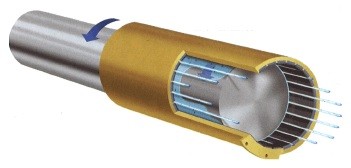 .
.
Hydrodynamic Grit and Sediment Rejection – A seal is created at the leading and trailing ends of the bearing “land” areas, causing hydrodynamic grit rejection – abrasive grit and sediment found encountered in the water is flushed out through alternating grooves, protecting the shaft from damage.
.
Why Rubber? – Rubber, when lubricated with water, becomes one of the most slippery materials available. Thanks to this property, when sliding on a wet metal surface, friction can be virtually eliminated, making it the perfect material for this purpose.
Other reasons why rubber is used in Duramax cutless bearings:
- When starved of water, rubber will not wipe or fail in a sudden catastrophic manner like harder surface materials. Rubber can crystallize but will always keep its form.
- Each rubber landing area acts as an independent bearing surface.
- Rubber bearings always have contact area due to the elastic properties.
- An equal weight of water can absorb twice the heat of oil lubricants
And the fact that these cutless bearings use water as the lubricant is very important – if water is used rather than oil, contamination seals are not necessary. If seals are not necessary, pumps and tanks may not be required either. This leads to a simpler shaft bearing system and immediate cost savings to the boater.
Rubber bearings are on more vessels around the world than any other material. Duramax Johnson Cutless Bearings have set unbelievable performance records that other bearing companies and materials are yet to meet.
About Duramax Marine
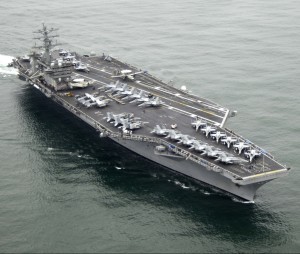 For more than 6 decades, marine professionals have been depending on Duramax Marine’s experience, continuing research and advancements in product technology. They manufacture not only water-lubricated bearing systems, but also shaft sealing systems, heat-exchange systems and impact protections systems for the marine industry.
For more than 6 decades, marine professionals have been depending on Duramax Marine’s experience, continuing research and advancements in product technology. They manufacture not only water-lubricated bearing systems, but also shaft sealing systems, heat-exchange systems and impact protections systems for the marine industry.
Duramax has invested millions in R&D to better understand and improve the tribological (study of science and engineering of interacting surfaces in relative motion) interactions of cutless bearings and other water lubricated bearings. This has allowed Johnson Cutless Bearing’s to set performance records that competitors are yet to meet. This is why more than 90% of U.S. Navy surface ships and submarines operate with Duramax water-lubricated bearing systems.
Many have tried to copy the Duramax Johnson Cutless Bearing, but none have the knowledge to produce the proprietary rubber formulations or quality of manufacturing.
Questions, Comments on Duramax Johnson Cutless Bearings, or Installation of your Cutlass Bearing? Let Us Know. Or Buy Here!
If you have any questions as to Johnson Cutless Bearings, or cutlass bearings in general, let us know! Besides having the complete line of Johnson Duramax Cutless Sleeve Bearings, here…, we are marine / boating experts in general, and will be happy to share our knowledge!
Have a good one!
CitimarineStore.com
3300 NW 112th Ave,
Doral (Miami-Dade), FL 33172
(800) 766-5256
info@citimarine.com
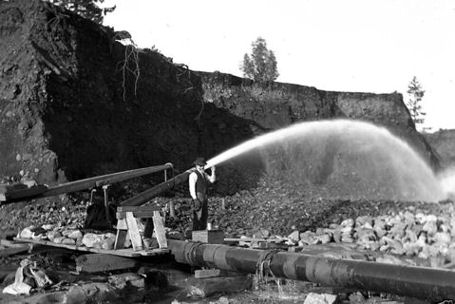
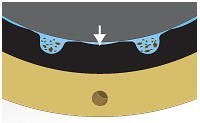









4 Comments
Please kindly be informed for AHTS vessels, Sea water lubricated Propeller shaft Bearing Bush is needed, so it will be appreciated if you send us Proforma Invoice regarding attached requisition.
Sea Water Lubricated
Length : 6000 mm
Inner Diameter : 30 mm
Outer Diameter : 50 mm
Material : Thordon and Ferro Foam
Hello Mohammad, I believe you may be off on a couple of the measurements. No worries, please send an email to sales@citimarine.com, and they will be able to get you the bearing you need.
hello do you have supply in the United Arab Emirates .
I am looking for non metallic cutlass bearings.
Shaft size : dia 70 mm
Bearing OD 95.30 x ID 73.46 x 292.1 MM
QTY : 2 PCS.
REGARDS
KRISHNAN
Hello Krishnan,
We sell quite a bit to the UAE, and yes, we carry the non-metallic cutless bearings you’re looking for. Please contact me at david@citimarine.com.